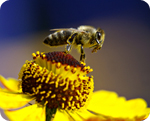
Mysterious collapse of honeybee populations threatens national food supply
Wednesday, March 21, 2007 by: Christian Evans
Tags: honeybees, pollinators, food supply
- Oncologist warns of ‘terrifyingly aggressive’ cancers in children, linked to immune suppression from COVID vaccines
- NIH study, buried for decades, reveals that Flu Shots INCREASE elderly deaths, not prevent them
- COVID-19 scandal linked to CANCER SURGE: Billionaire researcher sounds alarm
- Musk targets “strangely wealthy” lawmakers in DOGE probe, names Pelosi, McConnell, Schumer
- Ancient kitchen secrets REVEALED: How garlic, ginger and green onions fight cancer and heart disease
- DARPA: The shadowy innovator behind the world’s most advanced military technologies
- Millionaire fitness coach charged in Tesla vandalism incident as anti-Musk attacks escalate
- “Ethically sourced” human “bodyoids” could usher in a new era of medical exploitation, raising disturbing ethical questions
- Newly released JFK files reveal Pentagon's role in creating Lyme disease and covid in the same lab
- European Court of Justice: Healthcare professionals who promoted or administered COVID-19 vaccines are CRIMINALLY LIABLE for any harm caused
- Britain’s descent into police state censorship: Parents raided for questioning their daughter’s school system online
- RFK Jr. is pushing Big Pharma ad ban - and corporate media is panicking
- Tackling the rubber waste crisis: Groundbreaking study reveals eco-friendly method to recycle tires
- Homesteading Boom: How families are escaping cities to grow their own food
- Joseph Farrell’s “The Cosmic War”: Did an interplanetary conflict reshape the solar system?
- NYT admits U.S. ran Ukraine war operations-Russia's victory exposes obsolete NATO tactics, says Mike Adams
- Utah governor allows ban on LGBT pride flags in public buildings and schools, will take effect without his signature
- Civil war is here – Multiple events, from conservatives being “swatted,” to attacks against Telsa owners, happening across America as Dem politicians are telling supporters to ‘fight in the streets”
- Newly released JFK files reveal Pentagon's role in creating Lyme disease and covid in the same lab
- CDC finally halts $11 billion COVID funding scam as health officials admit the ‘pandemic’ was a fraud
- Analysis: The coming economic collapse, a mass uprising and Trump's three secret weapons to halt the growing revolt
- Kiss Your Genetic Privacy Good-Bye! 23andMe Gets Green Light to Sell Your Intimate Genetic Details to Anyone They Want
- Dr. Suzanne Humphries makes bombshell appearance on Joe Rogan podcast, exposing vaccine industry deception back to POLIOMYELITIS
- DEADLY DECEPTION: How COVID vaccines increased mortality rates and why authorities hid the truth
- Woman contracts WORLD'S DEADLIEST VIRUS after unknowingly being given the WRONG VACCINE
- Oncologist warns of ‘terrifyingly aggressive’ cancers in children, linked to immune suppression from COVID vaccines
- Here are TEN all-natural ways to protect your garden without using harmful chemicals
- Black cumin seed oil emerges as a powerful ally against breast cancer and chronic inflammation
- The hidden dangers in your kitchen: How cooking methods impact diabetes, cancer and aging
- Trump's greatest betrayal so far: Accelerating Middle East wars, silencing dissent, and serving Zionist masters
- Senate Democrats deny censorship industrial complex existed, defend government's role in silencing dissent
- Sugar-free deception: Artificial sweeteners hijack hunger signals, fuel obesity epidemic, study warns
- “Independent” anti-Russia outlet MEDUZA faces COLLAPSE as US funding dries up
- NIH study, buried for decades, reveals that Flu Shots INCREASE elderly deaths, not prevent them
- The Health Ranger releases “Vaccine Zombie” song and music video, using AI-animated zombies for the music video
- Discovery of vast underground city beneath Giza pyramids challenges human history
- Newly released JFK files reveal Pentagon's role in creating Lyme disease and covid in the same lab
- California's social media censorship law struck down: A victory for free speech or a threat to online safety?
- EPA advisor admits the agency is funneling billions to climate groups ahead of Trump’s return to White House
- The Health Ranger releases “Vaccine Zombie” song and music video, using AI-animated zombies for the music video
- Dr. Mike Yeadon releases 15-minute testimony - WATCH - about genocidal intent of COVID “vaccines”
- Florida takes a stand: DeSantis proposes permanent ban on mRNA vaccine mandates
- Mike Adams releases country western hit single: Goin’ Back in Time is Comin’ Home
- “Why we influenced the 2020 elections”: Facebook files reveal the coordinated effort to bury the Hunter Biden laptop story
- Unpacking the Lies That We’ve Been Fed – new song and music video released by Mike Adams, the Health Ranger
- House Intelligence Committee calls for the ARREST and PROSECUTION of Dr. Anthony Fauci
- The pandemic as a tool for INDOCTRINATION: Understanding “The Indoctrinated Brain” by Dr. Michael Nehls
- Rep. Nancy Mace introduces bill to ban biological males from female facilities on federal property
- Mike Adams releases music poetry sensation: A Child of God
- Sugarcane extract superior to cholesterol-lowering drugs?
- Survival 101: Effective EMF blocking techniques
- Michigan sheriff announces criminal investigation into 2020 election crimes, Dominion Voting Systems
- Peter Rost exposes Big Pharma corruption in his book “The Whistleblower: Confessions of a Healthcare Hitman”
- Migrants are taking advantage of recent hurricanes to scam residents and loot their homes
- Red Cross issues warning to stop blood plasma donations from vaccinated people
- Scientists confirm: GENIUS brain function can be spontaneously unleashed in humans without any apparent cause
- EPA advisor admits the agency is funneling billions to climate groups ahead of Trump’s return to White House
- HYSSOP: What research reveals about the health benefits of this ancient holy herb
- Two containers with completed ballots fall out of truck in Florida
- Fully vaccinated about to see “tsunami” of illness and death, warns virologist
- Global leaders unite to clamp down on “misinformation” with UN-backed Cascais Declaration
- BREAKING: 2025 NDAA authorizes mandatory military draft of WOMEN across America… as Pentagon pursues global NUCLEAR war with both Russia and China at the same time
- Michael Yon warns of a ZIONIST TAKEOVER in Trump’s second administration
- BOMBSHELL: DNA testing kits are a SCAM to develop ethnic-specific bioweapons
- Ozempic and Wegovy weight loss drugs are injectable LIZARD VENOM PEPTIDES that may unleash a devastating wave of organ failure… side effects align with symptoms of SNAKE BITES
- Israeli soldiers accused of even more torture and abuse in the West Bank
- These 13 countries just signed an agreement to engineer a global FAMINE by destroying food supply
- NASA admits that climate change occurs because of changes in Earth’s solar orbit, and NOT because of SUVs and fossil fuels
- RFK Jr. clears key hurdle: Sen. Susan Collins backs controversial HHS nominee, signaling a new era for health policy
- Sermon 30: How Jesus reveals Caesar’s FAKE CURRENCY and FALSE AUTHORITY
- Coriander seeds: Ancient medicine backed by modern science
- Arizona officials claim Maricopa County needs 10-13 days to tabulate results of the election
During the final three months of 2006, a distressing number of honeybee colonies began to diminish from the United States, and beekeepers all over the country have reported unprecedented losses. According to scientists, the domesticated honeybee population has declined by about 50% in the last 50 years.
Reports of similar losses to the honeybee population have been documented before in beekeeping literature, but are widely believed to have occurred at this scale previously only at a regional level. With outbreaks recorded as far back as 1896, this is regarded as the first national honeybee epidemic in U.S. history.
The phenomenon, referred to as Colony Collapse Disorder (CCD), is not yet well understood. Even the existence of the disorder remains in dispute. Nevertheless, what cannot be denied is that a shortage of honeybees in the continental U.S. has affected cropowners from California to the New England states.
"There are shortages [like this] that pop up from time to time," said Claire Kremen, a conservation biologist at Princeton University. "Whether there are more [shortages] than there were 20 years ago, one would guess yes, as there are fewer bees to go around, but it's not well documented."
Subsequent investigations suggest these outbreaks of unexplained colony collapse were experienced by beekeepers for at least the last two years. Are the honeybees dying in the fields they pollinate, or do they simply become too exhausted and disoriented to find their way back home?
Why honeybees are the invisible link to an abundant food supply
Whatever the reason, why should we care so much? Why should it matter at all to Americans?When entire bee populations seem to disappear or die out in alarming numbers, the ramifications can be astounding. Bee pollination, which most farmers depend on, is responsible for as much as 30% of the U.S. food supply.
"Every third bite we consume in our diet is dependent on a honeybee to pollinate that food," said Zac Browning, vice president of the American Beekeeping Federation.
A Cornell University study has estimated that honeybees annually pollinate more than $14 billion worth of seeds and crops in the United States. These include such diverse food sources as almond blossoms, pumpkins, cucumbers, raspberries, avocados, and alfalfa. Unless something is done to protect the honeybee population soon, many fruits and vegetables may disappear from the food chain.
"The sudden and unexplained loss of honeybee populations is an early warning sign for coming disruptions in modern agriculture," explained Mike Adams, executive director of the Consumer Wellness Center non-profit group (www.ConsumerWellness.org). "If we continue to lose honeybees at this rate, we may find ourselves in a dire food supply emergency that will not be easily solved," Adams said.
"During the last three months of 2006, we began to receive reports from commercial beekeepers of an alarming number of honey bee colonies dying in the eastern United States," said Maryann Frazier, a senior extension associate in the Department of Entomology at Pennsylvania State University's College of Agricultural Sciences.
"Since the beginning of the year, beekeepers from all over the country have been reporting unprecedented losses. This has become a highly significant yet poorly understood problem that threatens the pollination industry and the production of commercial honey in the United States," she said.
Honeybees are killed by synthetic chemicals
Scientists, for now, have primarily attributed the honeybee decline to diseases spread as a result of mites and other parasites as well as the spraying of crops with pesticides. It may also result from the treatment of forests, rangelands and even suburban areas to control a wide variety of pests."There is no question that the extremely irresponsible use of synthetic chemicals in modern farming practices is significantly contributing to this devastating drop in honeybee populations," said Mike Adams. "The more chemicals we spray on the crops, the more poisoned the pollinators become. And the fact that honeybees are now simply disappearing in huge numbers is a strong indicator that a key chemical burden threshold has been crossed. We may have unwittingly unleashed an agricultural Chernobyl."
In order to deal with this devastation, a newly formed CCD working group has been organized in hope of finding a solution to the dwindling honeybee population. According to the CCD mandate, the group will explore "the cause or causes of honeybee colony collapse and finding appropriate strategies to reduce colony loss in the future."
Comprised of university faculty researchers, state regulatory officials, cooperative extension educators and industry representatives, the working group hopes to develop management strategies and recommendations for this epidemic. Participating organizations include the USDA/ARS, the Florida Department of Agriculture, the Pennsylvania Department of Agriculture, Pennsylvania State University, and Bee Alert, Inc., a technology transfer company affiliated with the University of Montana.
Research involving the value of honeybees to agriculture could be beneficial to both the beekeeper and the grower. The knowledge formed from such research maximizes the likelihood of finding answers that will aid beekeepers in promoting good health for honeybees within the pollination industry. It should also keep the grower well informed about the process of pollination and the relative damage of different pesticides to honeybee populations.
A detailed, up-to-date report on Colony Collapse Disorder can be found on the Mid-Atlantic Apiculture Research and Extension Consortium Web site at http://www.maarec.org
The pesticide link to honeybee populations
Pesticides, specifically neonicotinioid pesticides, including imidacloprid, clothianiden and thiamethoxam, poison the bee while it is in the process of collecting nectar and pollen. The poisoning may occur when the material is ingested, or it may be transported to the hive where it poisons other bees in the colony.According to a recent report, "Pesticides in Relation to BeeKeeping and Crop Pollination, even organic insecticides -- the chlorinated hydrocarbons, organophosphates, and carbamates -- vary in their toxicity and are not recommended."
Pesticides can also damage wild bees, but the toxicity level of a specific insecticide to honeybees and wild bees is not always the same. Even among wild bees, some materials are more toxic to one species than to another.
According to the CCD report, "If bees are eating fresh or stored pollen contaminated with these chemicals at low levels, they may not cause mortality but may impact the bee's ability to learn or make memories. This could cause the colonies to dwindle and eventually die."
So far a few common management factors have been found, but no common environmental agents or chemicals have been identified. There is no one substance currently being branded as the culprit.
Not limited to the United States, this problem is complex and the ramifications are alarming. Such a loss to the honeybee population can occur in other countries that have highly developed agricultural infrastructures.
This only begs an even deeper question for society to answer: If we are so dependent on honeybee pollination for our food supply, what happens when the bees are wiped out? Mike Adams calls our current food production situation a "food bubble" and explains that as mankind disrupts nature and destroys sustainable ecosystems, the natural backlash will impact the food supply first. "Following a century of synthetic chemical poisoning of planet Earth, the human race is in for a rather abrupt population correction. The collapse of pollinators is merely a sign of things to come. Humans will either find a way to live in balance with the planet, or they may ultimately face the same fate as the honeybees."
Honeybees at FETCH.news
Get independent news alerts on natural cures, food lab tests, cannabis medicine, science, robotics, drones, privacy and more.
Take Action: Support Natural News by linking to this article from your website
Permalink to this article:
Embed article link: (copy HTML code below):
Reprinting this article:
Non-commercial use OK, cite NaturalNews.com with clickable link.
Follow Natural News on Facebook, Twitter, Google Plus, and Pinterest
Science News & Studies
Medicine News and Information
Food News & Studies
Health News & Studies
Herbs News & Information
Pollution News & Studies
Cancer News & Studies
Climate News & Studies
Survival News & Information
Gear News & Information
News covering technology, stocks, hackers, and more



"Big Tech and mainstream media are constantly trying to silence the independent voices that dare to bring you the truth about toxic food ingredients, dangerous medications and the failed, fraudulent science of the profit-driven medical establishment.
Email is one of the best ways to make sure you stay informed, without the censorship of the tech giants (Google, Apple, Facebook, Twitter, YouTube, etc.). Stay informed and you'll even likely learn information that may help save your own life."
–The Health Ranger, Mike Adams













































